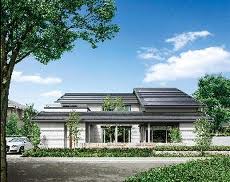Imagine this: Total Electric Living… where electricity does absolutely everything: heats, air conditions, cooks, preserves food, lights, entertains, encourages hobbies, makes it the easiest way ever for you and your family to be happier, healthier, to live fuller lives.
Sound familiar? It should: while it dates back to the 1950s, that quote from a Westinghouse ad for the “Total Electric Home” is strikingly similar to today’s ads for new “smart homes”.
Today, US home automation company Control4 invites us to:
Imagine a house that remembers to lock itself at 10pm. Shades that close as the sun hits. A home theater setup that takes care of lights, sound and picture with one touch. With Control4, everything works together the way you want it to. Life is just better with a little more control.
Both visions promise homes that take care of themselves, and those that live in them, with us barely needing to lift a finger.
But there is one critical difference. The 21st century smart home also promises to deliver substantial energy savings through automated appliances and smart heating and cooling systems. Sound too good to be true? You may be onto something.
Smart home technologies are now being advocated not only by home automation companies, but by governments and energy providers as well. While there are energy efficiency gains to be had, it is important to pay attention to the new ways of life these technologies promote, and what this might mean for future energy consumption.
Lessons from the past
History provides many reasons to be cautious about dream home aspirations. For a start, utopian visions of our future lives and homes rarely come to pass as intended. They are like the pot of gold at the end of the rainbow: tantalisingly close, but never within our reach.
Nonetheless, the continual promotion of new ways to live are always productive in one way or another, just not necessarily in the ways they were intended.
The industrial revolution of the home and the proliferation of labour-saving devices like vaccuum cleaners, irons and washing machines, was intended to free women from the daily drudgery of housework. And in many ways it did.
But as Ruth Schwartz-Cowan succintly points out, it also served to increase expectations of cleanliness, creating “more work for mother”.
As mother has worked harder, our dependency on the various appliances we now consider essential for modern day living has grown, along with the energy needed to power them.
Old expectations for a new future
It is possible to speculate on how “smart” cleaning, entertaining, security, heating and cooling technologies might ratchet up our expectations for these services, potentially undermining some energy efficiency benefits.
This is often the explicit aim of home automation companies, which promise to “elevate your standards” (Sony) and whose websites depict luxury and decadence on a Dubai-style scale. The smart lifesyle has one defining feature: it is all powered by electricity – albeit greener and more efficient electricity.
Remote controlled security lighting, for example, replaces the friendly neighbour or housesitter who keeps an eye on the place while you’re away. Similarly, automated climate-controlled heating and cooling systems can replace other ways of keeping warm or cooling down, like wearing more or less clothes, building climate-sensitive housing, or taking a cold shower.
This preoccupation with energy-dependent ways of life dates back to at least the 1930s. Westinghouse’s display-style ‘Home of Tomorrow’ celebrated its achievement of an electrical load equivalent to that of 30 average homes, “ready to do the work of 864 servants with the flip of a switch”.
What has changed between then and now is that, where the dream homes of the past glorified their high energy consumption, the smart homes of today promote their efficiency credentials. However, both are thoroughly subscribed to an energy-intensive lifestyle.
Reimagining the dream home
There is nothing wrong with imagining different ways to live. Indeed there has never been a moment in human civilisation when we have not. There is something captivating and thrilling about a future that to many people, will never be affordable or available. That’s what makes it so desirable.
However, what is troubling with these dream home visions, past and present, is their dependence on energy, or on electrically-enabled ways of life.
What we rarely see in the past or present are utopian aspirations for a way of life where homes are cooled without the need for mechanical heating and cooling, where security systems aren’t needed, or where cleaning doesn’t require new electrically-powered gadgets and devices.
When home automation companies invite us to imagine warming up our spa before we even get home, we might laugh, get excited, be appalled, or all three. But whatever our reaction, we should be concerned – not because the smart home of the future is destined to either fail or succeed, but because it might unfold in ways we weren’t intending.
It might rope us into new forms of work for mother, father and the rest of the family. And it might increase our expectations for energy-intensive lifestyles.
We do need new utopian visions for dream homes, but we can do better than ones that only involve automation and energy efficiency.
We can imagine homes with new ways of entertaining, securing, cleaning, cooking, heating and cooling. We can imagine homes that don’t need very much energy at all.
This article is based on content from Yolande Strengers’ recent book, Smart Energy Technologies in Everyday Life: Smart Utopia?
Yolande Strengers receives research funding from Australian energy providers and the Consumer Advocacy Panel![]()
This article was originally published at The Conversation.
Read the original article.








